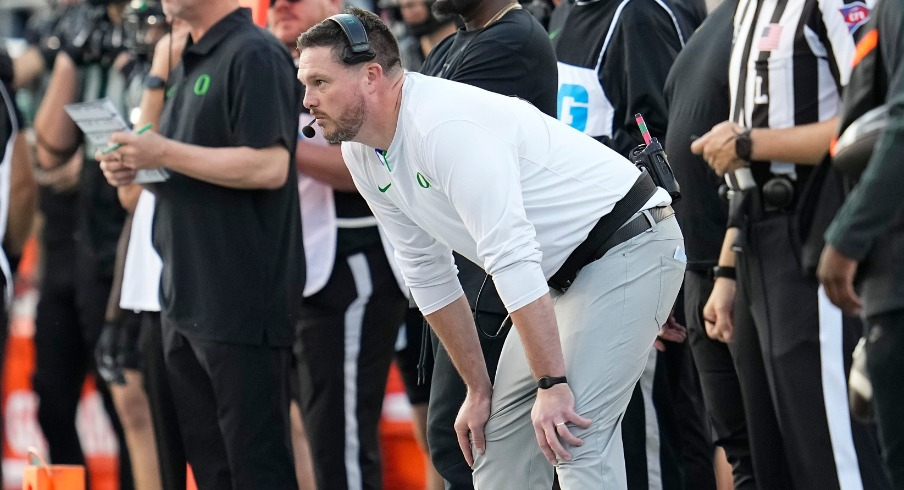Every second left on the clock made a difference at the end of Ohio State's game against Oregon.
All the evidence needed to prove that fact is the final play of the game, where Buckeye quarterback Will Howard slid to the ground one second too late to call a timeout and set up a game-winning field goal attempt in Ohio State's 32-31 loss.
One play before that final down on 3rd-and-25 with 10 seconds to play, the Ducks were penalized for having too many men on the field. The Buckeyes gained five yards to place them at Oregon's 38-yard line, but lost four seconds from the clock.
Per the NCAA rulebook in Rule 3, Section 5, Article 3, having too many men in defensive formation is a live-ball foul, meaning the time spent by Ohio State throwing an incomplete pass on the play is not added back.
Approved Ruling 3-5-3 II. — 3/5 @ B-35. Team B has 12 players in the formation, and no Team B player is attempting to leave the field while the ball is ready for play. Team A snaps the ball and the run by A44 gains 3 yards. RULING: Live ball foul, Team A 1/10 @ B-30.
....Approved Ruling 3-5-3 VI. Team A lines up for a two-point try attempt at the B-3. Team B has eleven players in its defensive formation. The 12th Team B player runs onto the field just before or just as the ball is snapped. A22 takes the handoff from the quarterback and (a) is tackled at the one-yard line; or (b) carries the ball into the end zone. RULING: Live-ball foul against Team B for illegal substitution.
That’s led to questions on whether Oregon intentionally put 12 men on the field to ensure Ohio State wouldn’t make a big play, knowing that the penalty would only give Ohio State five yards while wasting time in the process.
you NEED to watch how genius this is
— Warren Sharp (@SharpFootball) October 13, 2024
:10 left, Oregon calls a timeout
they intentionally add a 12th man late to ensure no big gain occurs
ball is snapped, no big gain
obviously its a penalty BUT
1) :04 ticks off clock
2) no big gain
:06 left
only time for 1 play
WIN pic.twitter.com/2MouQanBK8
It didn’t sound as though it was a mistake when Oregon coach Dan Lanning was asked Monday if the Ducks intentionally put 12 men on the field. While he didn’t directly confirm that Oregon intentionally sent an extra defender onto the field, he didn’t deny it either.
“There was a timeout before that. We spend an inordinate amount of time on situations. There's some situations that don't show up very often in college football, but this is one that obviously was something that we had worked on. So you could see the result,” Lanning said.
FOX analyst Joel Klatt is among those who think Lanning might have engaged in some gamesmanship. Given the rule stated above, he thinks it was a smart tactic deployed by the Ducks.
Oregon called a timeout right before the play in question. The 12th man who came onto the field, an extra defensive back, entered right before the snap of the ball, as Klatt pointed out in his podcast, The Joel Klatt Show.
"Based on the way that the film looked, it's hard for me to think that it was anything other than brilliant strategy from Dan Lanning and Oregon," Klatt said. "I don't think it was a mistake from Oregon. I might be wrong, OK, I might be wrong. But I do think that they put the 12th player out there in order for the snap not to count and in order to take extra time off the clock."
As wild as it may sound to some, there's precedent for such a maneuver at the professional level. It's even happened in a Super Bowl, though it was almost certainly unintentional in this case. With 17 seconds to play in Super Bowl XLVI – played on Feb. 5, 2012 after the 2011 season – and the New England Patriots possessing the ball at their own 44-yard line, New York Giants defensive end Justin Tuck failed to get off the field in time on a substitution. Bill Belichick and Tom Brady's bunch threw an incomplete pass that took eight seconds.
The Giants were flagged for the illegal substitution and penalized five yards, but with only nine seconds left on the clock, New York held on for a 21-17 victory. That offseason the NFL changed its rule to make too many men on the defense a dead-ball penalty while the offense remained a live-ball penalty.
Even after that rule change, Mike Vrabel appeared to purposefully put 12 men on the field to save time in a game while coaching the Tennesee Titans in 2020.
Mike Vrabel is outstanding
— Warren Sharp (@SharpFootball) October 19, 2020
1. he rushes in 46 late (12th man on D)
2. 33 is WTF
3. penalty for 12men
4. Vrabel fakes upset & brings 46 off
WHY?
-penalty stops clock
-time > yds
-knows HOU will score
Result:
- w :04 left, TEN scores tying TD
- move saved 40 seconds & won game pic.twitter.com/wikWKtGuJD
There is one exception that could have put time back on the clock for Ohio State. Rule 9, Section 2, Article 3 of the NCAA rulebook stipulates a type of unsportsmanlike conduct foul where a team commits blatant and obvious “unfair acts” designed to waste time at the end of the game. Referees are then to assess a 15-yard penalty and may take any action they deem necessary to right the wrong. The exact ruling for such unfair acts is as follows:
PENALTY— Unsportsmanlike conduct. The referee may take any action they consider equitable, which includes directing that the down be repeated, including assessing a 15-yard penalty, awarding a score, or suspending or forfeiting the game.
Below is the top example of an “unfair act” given by the NCAA rulebook:
Team A, trailing by nine points, has 1st-and-10 on the B-22 with 0:35 showing on the game clock. At the snap, B21, B40 and B44 blatantly hold, wrapping both arms around Team A’s wideouts and take them to the ground. Quarterback A12 has no receiver in the route, scrambles and then legally throws the ball away. After the play, the game clock reads 0:26. The back judge, field judge and side judge have a flag down for Team B holding on each of their keys. RULING: This is a blatant and obvious unfair act designed to take time off the clock. The referee will convert the holding fouls to an unsportsmanlike conduct fouls. Penalize half the distance to the goal. Team A will have 1st and 10 at the B-11. The game clock is reset to 0:35 and starts on the next snap. B21, B40 and B44 each have one unsportsmanlike foul counter.
Three defensive backs tackling opposing receivers to take holding flags and remove time from the clock, as in the example above, doesn't seem as “blatant and obvious” as a 12th man coming onto the field late. That can easily be explained as a miscommunication, though, so even if the refs suspected Lanning of putting 12 men on the field just to waste time, it would have been hard for them to legislate anything about it.
Ohio State coach Ryan Day didn’t express any displeasure that the play wasn’t blown dead during his Monday appearance on the Buckeye Roundtable show. The right move might have been to spike the football and stop the clock if the 12th man is noticed pre-snap, Day said, but he still felt the Buckeyes had the opportunity to make a play even with the extra man on the field.
"In that situation, if you were to see 12 or 13 guys or whatever – I mean, I guess they could put 20 guys on the field if they wanted to – I guess you would spike it so that you save that time," Day said. "And then you just get five more yards. But when you look back on the play, there were guys open. There was still an opportunity to make a play there."
The Big Ten cited the NCAA rulebook stating that 12 men on the field is a live-ball foul in response to an inquiry from Eleven Warriors regarding the assessment of the penalty.
The simple solution is for the NCAA to follow in the NFL's footsteps and make too many men on the defense a dead-ball penalty. But from Ohio State's perspective, it's just another in a line of what-ifs from its one-point loss on Saturday.


